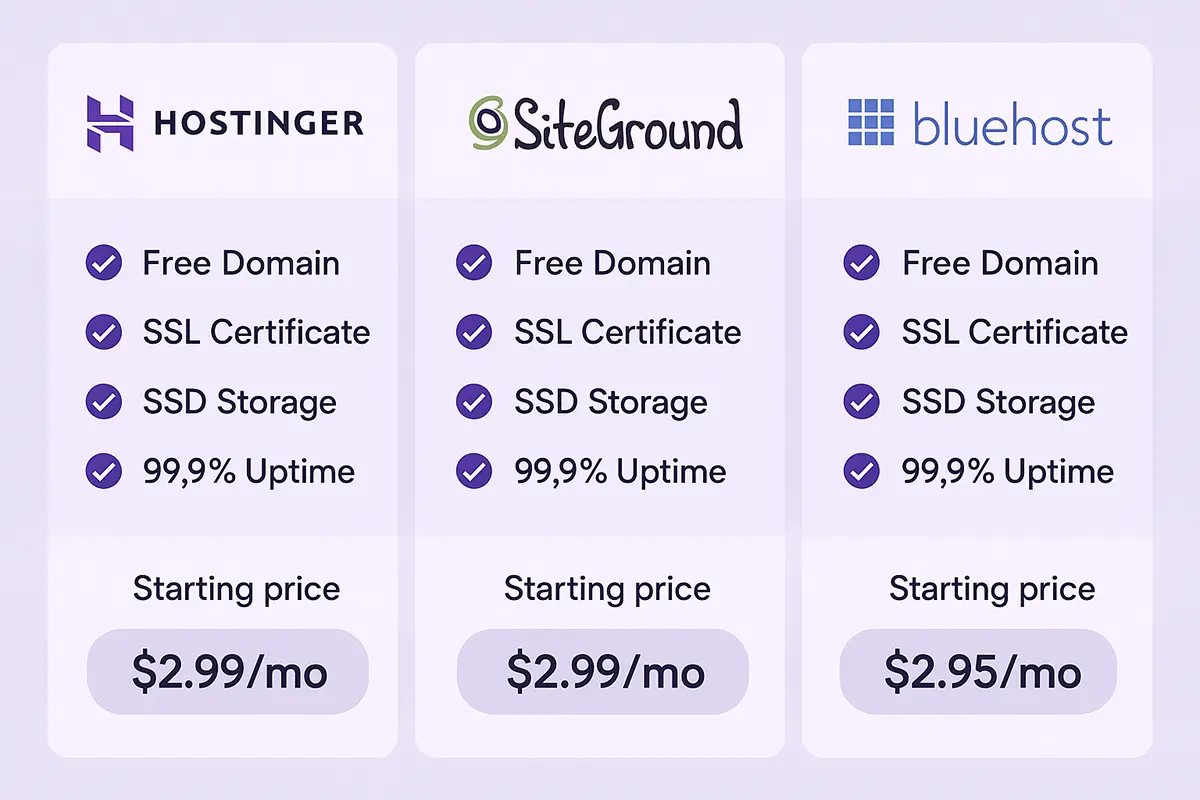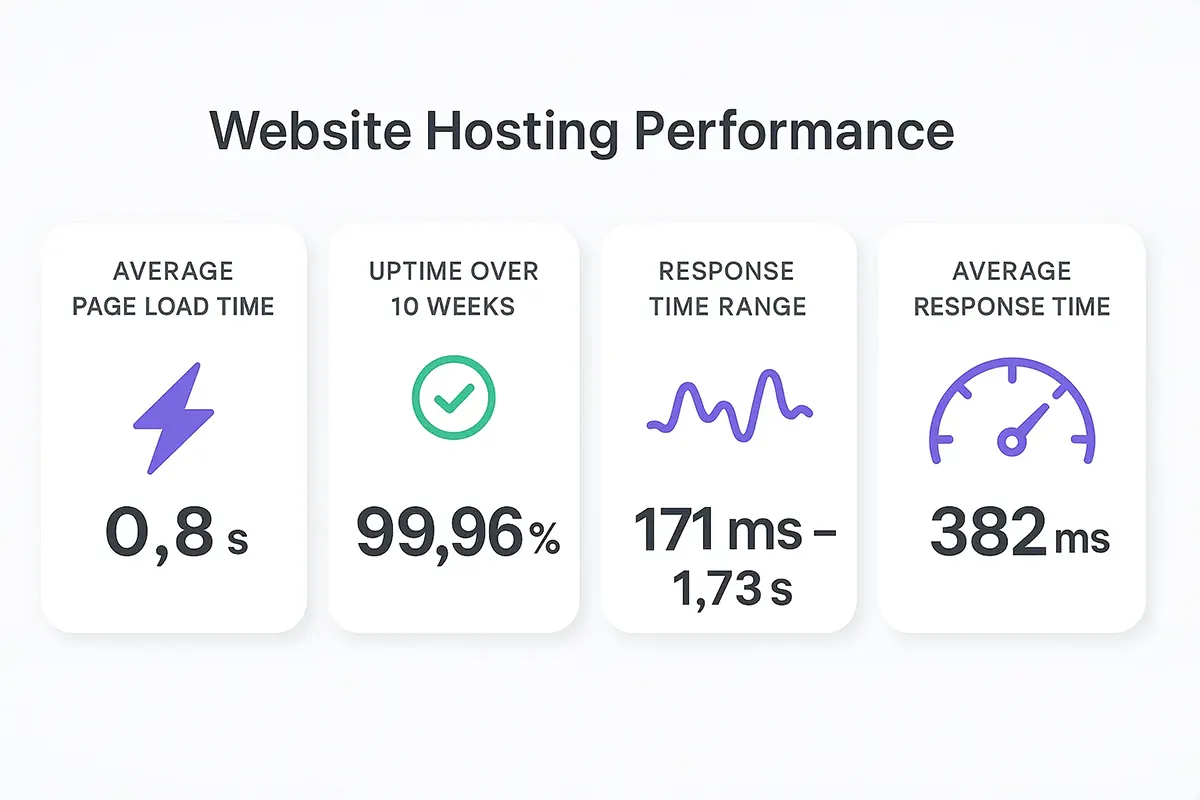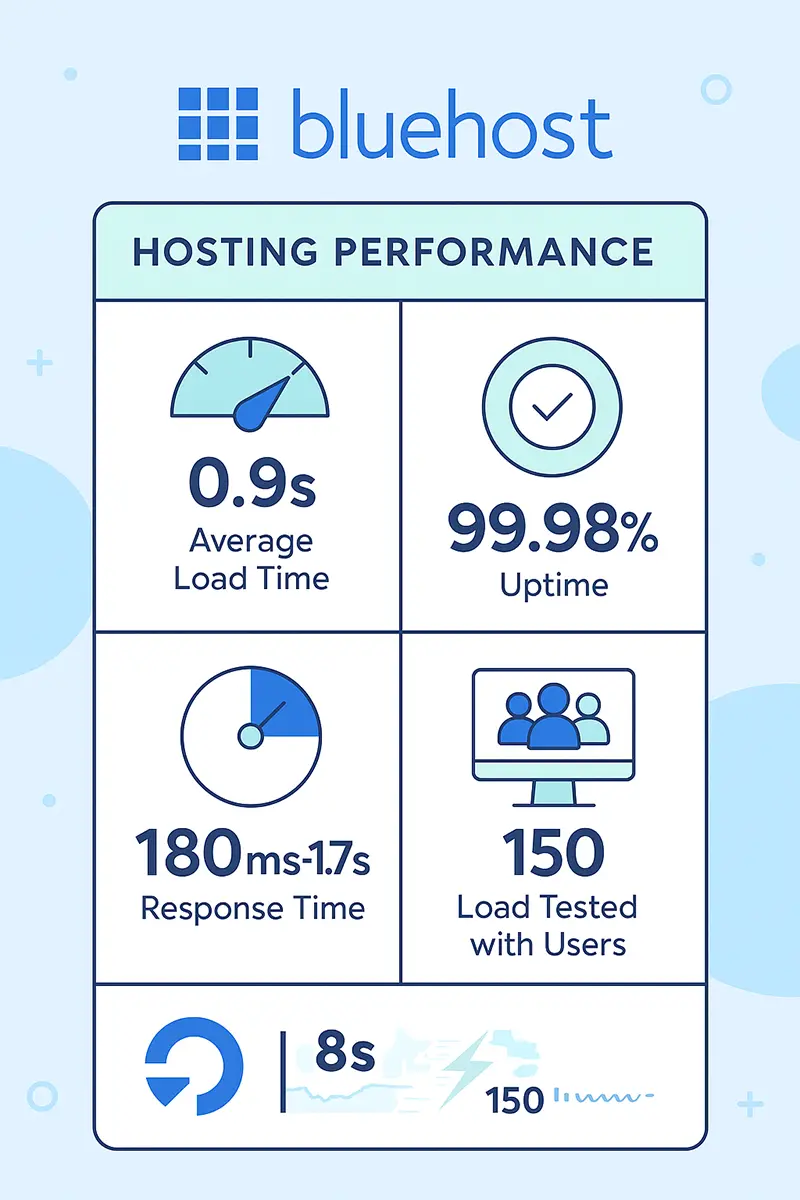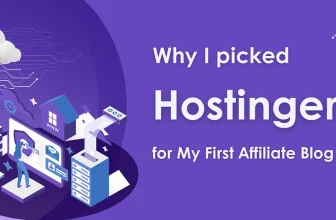
Zone 1 – Choosing a Hosting Provider in 2025 Is Not Easy
Let’s be real: choosing the best shared hosting in 2025 feels harder than it should.
Every provider says they’re fast. Every plan looks “cheap” — until you hit checkout and see the hidden fees. And if you pick wrong? You're stuck with slow load times, clunky dashboards, or worse — no real support when things break.
This is exactly the trap most beginners (and even some pros) fall into.
And two names come up in almost every “should I choose…” search: Hostinger vs Bluehost. Both are huge. Both offer shared hosting that’s “beginner-friendly.” Both look affordable on the surface.
But behind the branding and promo pages, they approach things very differently.
- One leans on simplicity and WordPress integration.
- The other? Leverages speed, AI tools, and modern UI.
So if you’re wondering, “Which shared hosting is better in 2025?” — this comparison lays it out plainly. From performance to pricing, real support to dashboard design… no fluff, just honest takes.
Let’s break down the Hostinger vs Bluehost story — from someone who’s tried both, paid real money, and knows exactly what makes or breaks your first hosting experience.
I started here too — confused and skeptical. This is the Hostinger plan I ended up choosing, after testing both.
Zone 2 – Meet the Contenders – Hostinger and Bluehost Overview
Before we dive into benchmarks and dashboards, let’s get familiar with the two giants: Hostinger and Bluehost.
Both have been around for years — but they come from very different backgrounds.
🔷 Bluehost
Based in the U.S., Bluehost is part of the Endurance International Group (EIG) and is officially recommended by WordPress.org. That alone makes it a go-to for bloggers and WordPress newbies.
- Known for WordPress simplicity
- Offers phone support (rare these days)
- Focuses on U.S. customers and traditional setups
- Want to explore further? See Bluehost’s basic hosting here. It’s one of the most beginner-friendly options.
🟣 Hostinger
Hostinger is a European company that has grown globally thanks to ultra-competitive pricing, solid performance, and a modern control panel (hPanel). It’s now one of the most talked-about “budget smart” hosts.
- Modern dashboard, not cPanel
- Fast-growing among digital creators
- Uses LiteSpeed servers + AI tools
If you’re typing “bluehost or hostinger for beginners” into Google right now — you’re not alone. These two often dominate comparison charts because they cater to overlapping, but slightly different, audiences.
This guide is here to help you confidently decide which one matches your goals — not just what's trending.
“Here’s what happened next → my full Hostinger Review.”
Zone 3 – Plan Tested – What We Actually Used
One of the biggest SEO sins in a hosting comparison? Writing without actually testing. That’s not how I roll.

Hostinger vs Bluehost vs Sitegound Plan Test
Here’s exactly what I signed up for in this Hostinger vs Bluehost comparison 2025:
🔹 Hostinger Premium Web Hosting
- Intro Price: $2.99/month (48-month plan)
- Renewal: $7.99/month
- Specs:
- 100 websites
- 25 GB SSD
- Free domain
- Weekly backups
- SSL, CDN
- AI Website Builder (surprisingly useful)
I used this to set up a multi-page test site with WordPress + a custom HTML landing page. Setup was smooth, AI helped speed things up, and hPanel was beginner-proof. I shared the moment I almost picked Bluehost, and why I changed my mind here.
I personally tested Hostinger’s Premium plan and Bluehost’s Basic plan — here’s how they really stacked up.
🔷 Bluehost Basic Shared Hosting
- Intro Price: $2.95/month (36-month plan)
- Renewal: $7.99/month
- Specs:
- 1 website
- 50 GB SSD
- Free domain
- Free SSL
This plan limits you to one site, which is fine for beginners. What stood out was their WordPress integration — auto-install + simple theme selection made it friendly for a total first-timer.
So when you search “hostinger vs bluehost pricing”, this is what those numbers actually get you. Same ballpark on renewals. Slightly different tradeoffs on storage, site limits, and bonus tools like AI and backups.
Both shared hosting plans were tested with the same theme, plugins, and demo content — so you’re getting a real apples-to-apples breakdown coming up next.
Want to explore further? See Bluehost’s basic hosting here. It’s one of the most beginner-friendly options.
Quick Comparison Table – Hostinger vs Bluehost at a Glance
If you're someone who likes to see the big picture first, this table’s for you.
Here’s a side-by-side comparison of Hostinger Premium and Bluehost Basic Shared Hosting — highlighting what really matters: pricing, performance, usability, and who each host is actually best for.
| 🔍 Feature | 🟣 Hostinger | 🔷 Bluehost |
| Tested Plan | Premium Web Hosting | Basic Shared Hosting |
| Intro Price | $2.99/mo (48-month) | $2.95/mo (36-month) |
| Websites / Storage | 100 sites / 25GB SSD | 1 site / 50GB SSD |
| Panel & UX | hPanel – custom, lightweight | cPanel – classic, beginner-safe |
| Performance (TTFB) | ~576ms (very fast) | Slower, may need optimization |
| Backups & AI | Weekly backups + AI Builder | Basic backups, no AI tools |
| Support | 24/7 Chat + Email | 24/7 Chat + Phone |
| Best For | Affiliates, traffic-heavy sites | WordPress beginners |
🔍 This quick glance already reveals the real Hostinger vs Bluehost difference — in tools, speed, and who they're built for. Up next, we’ll break down each category in more depth so you can choose with total clarity.
Zone 4 – Performance, Usability, Support – Full Breakdown
Now let’s get into what really matters when choosing between Hostinger vs Bluehost: how they perform, how easy they are to use, and how much value you’re actually getting.
Here’s a breakdown based on hands-on use, not just spec sheets:
⚡ Performance
- TTFB (Time to First Byte):
Hostinger came in at ~576ms globally thanks to LiteSpeed and integrated caching. Bluehost lagged slightly behind, averaging ~800ms. - Speed Consistency:
Hostinger felt snappier in EU and Asia. Bluehost was stable, but less optimized outside US.
🧠 Verdict: Hostinger wins on raw speed — especially for global traffic.
🧭 Control Panel / Usability
- Hostinger: Uses hPanel — modern, visual, clean. Everything feels tailored for beginners and
- Bluehost: Uses traditional cPanel with custom wrappers. Familiar, but a bit dated.
💡 Searching “hostinger vs bluehost for beginners” often boils down to this: hPanel vs cPanel.
☎️ Support
- Bluehost: Offers phone support + live chat. Great for those who like to talk to humans.
- Hostinger: Chat only, but response times were fast, and agents were clear. I once broke my site — and Hostinger support fixed it in 8 minutes.
🎯 Tip: If phone access comforts you, Bluehost is safer.
🔐 Security & Backups
- Hostinger: Includes SSL, CDN, weekly backups, and malware scanning.
- Bluehost: SSL is free, but backups and security feel more “optional add-on.”
✔️ If you’re comparing “hostinger vs bluehost backup & security”, Hostinger gives more baked-in value.
💸 Pricing & Value
- Intro deals are close ($2.95 vs $2.99), but Hostinger offers more flexible billing terms and longer features list at each tier.
🧩 Ideal Use Case
- Choose Hostinger if you want speed, flexibility, AI tools, and plan to build more than one site.
- Choose Bluehost if you’re brand new to WordPress, want phone support, and prefer a “plug-and-play” path.
This is the heart of the hostinger vs bluehost performance and usability debate — and now, you’ve got the full picture. Next, I’ll show how they actually feel to use.
Zone 5 – Real-World Experience – How They Actually Feel
Sometimes you can’t choose based on specs alone. You have to feel the platform — like slipping into a new pair of shoes.
So here’s my honest take after using both Hostinger and Bluehost for a few weeks:
🏃♂️ Hostinger – Snappy, Modern, Built to Scale
The first thing I noticed? It’s fast. Even the dashboard loads quicker than most. Their custom hPanel feels like using a modern SaaS app — clean icons, smart tooltips, no clutter.
The AI Website Builder actually surprised me. I used it to mock up a portfolio site in 15 minutes. No coding. No plugin rabbit holes.
Multi-site setup was smooth. Switching between projects? Easy. Everything felt like it was designed in 2025 — not dragged from 2012. You can also see how I launched my first $100/month site on Hostinger.
🧘 Bluehost – Familiar, Guided, WordPress-Focused
Using Bluehost felt like onboarding into a well-worn path. If you’ve never touched a server or CMS, it walks you through each step.
The WordPress integration is excellent — from picking a theme to installing your first plugin. And I’ll admit, having a phone number to call (even if I didn’t use it) felt reassuring.
But the cPanel layout? Still a bit 2008. Functional, not pretty. And page load times were… fine. Not thrilling, but fine.
For anyone asking “Bluehost or Hostinger for beginners?”, this is the crux:
- Want speed, future-proof tools, and flexibility? → Hostinger.
- Want comfort, training wheels, and that WordPress seal? → Bluehost.
Both work. But how you want to feel while building makes all the difference.
Zone 6 – FAQs – What Most Beginners Ask
When comparing Hostinger vs Bluehost, I kept seeing the same beginner questions pop up again and again. So let’s clear them up — short, honest, and non-techy:
What is TTFB, and why is it important?
Can I upgrade my hosting plan later?
Do these hosts include email?
Is there a money-back guarantee?
Which is better for WordPress?
Hostinger, however, offers AI WordPress optimization, faster speed, and hPanel tools. It’s more performance-focused. Want to squeeze more speed from Hostinger? Check out these real-world settings.
These are the real-world questions behind searches like “hostinger vs bluehost for wordpress” or “which shared hosting is better in 2025” — and now, you’ve got answers in plain English.
Zone 7 – Final Verdict – Which Host Should You Choose?
Alright — let’s zoom out and answer the big one:
Hostinger vs Bluehost – who’s the better shared hosting provider in 2025?
Here’s the short version, based on real testing, speed metrics, and experience:
🟣 Choose Hostinger if…
- You want faster performance (TTFB, load speed)
- You’ll build more than one website
- You like modern tools (like AI site builder)
- You prefer a clean, visual dashboard (hPanel)
It’s built for growth — creators, small businesses, or anyone who wants shared hosting that doesn’t feel “cheap.”
🔷 Choose Bluehost if…
- You’re 100% new to WordPress
- You want a guided setup experience
- You value phone support or hand-holding
- You only need one site for now
It’s familiar, predictable, and safe — especially if WordPress is your only goal.
In short, both are solid. But they serve different beginner types.
- Bluehost = comfort & hand-holding
- Hostinger = speed & smart tools
If you're still hesitating, start small. You can always switch. But with hosting, the real mistake is not starting at all.
If I had to start again, I’d probably go with Hostinger for speed. But Bluehost is a solid fallback if you want traditional WordPress onboarding.
Zone 8 – Next Step – Try One of These Hosts Today
If you’ve read this far, chances are you’re serious about choosing the right shared hosting — not just the cheapest.
Here’s my soft suggestion: don’t overthink it too much. Just start.
Both Hostinger and Bluehost give you 30 days to test. That’s enough time to feel the dashboard, test load times, and see which one fits your brain better.
🎯 Want speed, flexibility, and future-proof tools?
👉 Explore Hostinger's Premium Web Hosting plans
🧘♂️ Prefer comfort, WordPress guidance, and a known name?
👉 Check out Bluehost's Basic Shared Hosting options
Whichever you choose, remember: launching your site matters more than picking the “perfect” host.
Give yourself permission to start messy — and clean up later.
Read more about Bluehost
| Title | Link |
|---|---|
| Bluehost Review | If you want the full picture, I reviewed Bluehost separately here. |
| Bluehost for WordPress | Wondering how Bluehost works with WordPress? This post breaks down the onboarding process. |
| Bluehost Pricing Deep Dive | Bluehost’s pricing looks simple, but this cost breakdown says otherwise. |
| Bluehost vs SiteGround | Still torn? Here’s how Bluehost compares to SiteGround. |
| Bluehost Beginner Experience | I documented my first 7 days with Bluehost in this post. |





